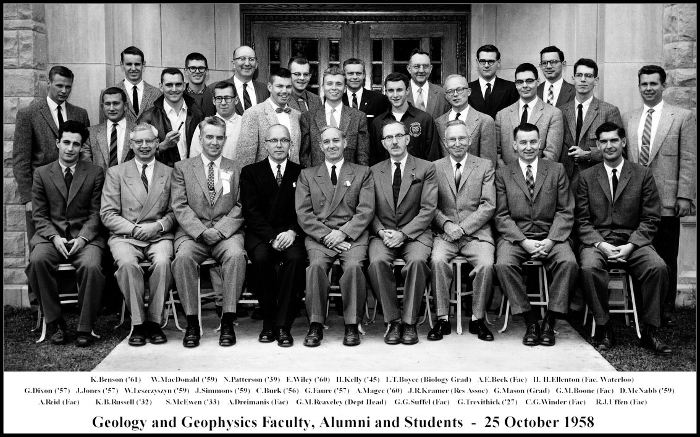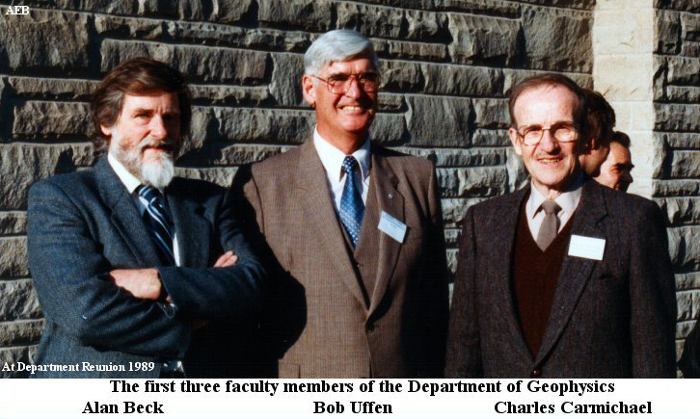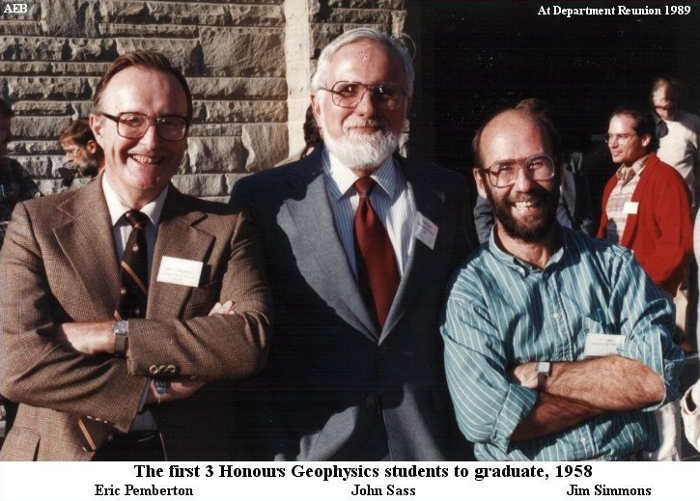A Brief History of the Department of Geophysics, 1958-1993
by Alan E. Beck
Professor Emeritus, Department of Earth Sciences
I. INTRODUCTION
It was a dark and stormy night and the villains were seated around the board room table. And the chief of the villains said to the sous chef "Antonia, let us create a Department of Geophysics". But Antonia said "Let us not be too precipitate." (she liked using long words when a short one would do). "Let us begin by transforming the Department of Geology into the first Department of Geology and Geophysics in Canada by adding Robert J. Uffen, a faculty member in the Department of Physics, to the Geology Department as Head, and sole member, of a sub-department of Geophysics and with Harold Reavely as Head of the sub-department of Geology; then after a year add Alan E. Beck, a PDF in the Department of Physics, to the sub-department of Geophysics and split the Department of Geology and Geophysics into two full departments, thus achieving another first for Canada and Western." (she also liked using long sentences). The chief said "That is a good idea and since we want Geophysics to start off mainly as a graduate department, let us give them a princely initial budget of $16,000 to cover everything including salaries" And so it came to pass, in July 1958, the year also being the occasion for a reunion to celebrate the initiation of the departments.
II. DEVELOPMENT OF THE FACULTY
A. The first ten years
In 1959 Charles M. Carmichael (Paleomagnetism) became a part-time lecturer in Geophysics. In the following year Mike Carr (Shock Wave Physics) and Alan Jessop (Heat Flow) were appointed PDFs. Then for the 1960/61year the villains got to work again and said "Let's make Uffen Principal of University College (essentially the Faculty of Arts and Science) and Beck acting-Head of Geophysics." But Beck said "Hold on a minute, I don't want the bloody job unless I can have more people." Since the villains were desperate they agreed and so it came to pass with Tad Ulrych (Age Determination) being appointed Lecturer until such time as he completed the formalities of his Ph.D. degree. Next year Tad Ulrych was appointed Assistant Professor and H. Currie Palmer (Paleomagnetism) and Robert F. Mereu (Seismology) came on board as PDFs.
In the meantime, advertising for a real Head of department proceeded. There were indeed responses, some from quite eminent people, but they took one look at the acting-Head and decided to stay where they were. And so it came to pass that in 1963 Beck was appointed Head of the department "during the pleasure of the Board" as things were done in those days; nobody seemed to realize that meant he could be fired without cause at any time. Also in 1963 Mereu was appointed Assistant Professor and Ulrych went on leave of absence and eventually wound up at UBC; leave of absence meant we had his salary to spend. At that time the newly created Department of Applied Mathematics wanted to appoint Douglas E. Smylie but did not have the salary available until the following year so Smylie was appointed Assistant Professor of Geophysics pro tem (there was remarkable cooperation and less administrative bull in those days).
For some obscure reason Geophysics became entitled to a permanent, more senior, faculty position but argued for a visiting Associate Professor position on the grounds that as a small department we would need to be stimulated in areas that were not our main areas of expertise. Thus, in 1964, Wojtek Domzalski, an exploration geophysical consultant, became our first visiting Professor, John H. Sass (Heat Flow), who had obtained his M.Sc. with Beck as supervisor, came on board as a PDF after obtaining his Ph.D. degree at the Australian National University. The next year, 1965/66, Beck went on sabbatical leave, Carmichael was appointed acting-Head, H. Takahashi (a gamma ray specialist) replaced Domzalski, Smylie transferred to Applied Mathematics and Mansinha (model seismology) came in as a visiting lecturer
In the 1966 academic year, U. Aswathanarayana (Geochemistry) replaced Takahashi, Mansinha and Palmer were appointed assistant Professors, while Akio Hayatsu came on board as a Research Associate to look after the K-Ar dating aspects of the paleomagnetic work and later became a full time faculty member. The following year Sam Warren Carey, a dynamic tectonics man, filled the visiting Professor position, Smylie transferred back to Geophysics, later moving to UBC, and Kegong Shih (Heat Flow) came for the year as a PDF. In the 1968/69 year Helmut Schloessin was appointed to undertake the task of developing a High Pressure - High Temperature (HPHT) laboratory for the determining physical properties of rocks and minerals at lower crust - upper mantle conditions.
B. The rest of the years
From then on, the full time faculty establishment was fairly stable for many years but we were kept on our toes by sabbatical leaves and the many arrivals and departures of Visiting Professors under our own or international programs (W. Domalzalski, H. Takahashi., U Aswathanarayana, Sam Carey, John Jaeger, Ron Green, Frank Stacey, R. G. Park, Karsten Storetvedt, Jim Briden, Richard Facer, Henry Pollack, Akito Ikami), and Post Doctoral Associates (Michael Carr, Alan Jessop, John Sass, Ke-Gong Shih, Roy White, Mangat Thapar, Zbinek Dvorak, Umesh Chandra, John Conaway, Valiya Hamza, Bill Morris, Rada Govindarajan, Po-Yu Shen, Dapeng Wang, T. E. Day,Y-x. Zhao, Z-. Jin, Milan Kresl, Kelin Wang, M. N. Beghoul).
The year 1988/89 was one of the most important in the history of the department; it saw our first retirements. Two faculty, Carmichael and Schloessin, and Y. Ling our highly regarded instrument maker. We all realized that it was probably the beginning of the end. In 1990/91 Richard A. Secco was appointed Assistant Professor to fill the hole left by Schloessin.
On 30 June 1993, the day Beck was to retire, the Department of Geophysics and the Department of Geology were also retired and metamorphosed into the Department of Earth Sciences which has since prospered.
All faculty members were active professionally, serving on (and in a number of cases chairing) local, institutional, provincial, national and international committees on education, research policy and grants selection.
III. DEVELOPMENT OF RESEARCH PROGRAM
The direction of development was to select those areas in which the University already had some reputation and develop these into the areas of strength. The areas selected were palaeomagnetism and geothermics (including the thermal history of the earth). Later on, it became obvious that seismology was both a popular subject and an area of considerable significance to Canada; this was therefore added to the list of areas of concentration.
Out of palaeomagnetism there arose a need for age determinations. Initially, these were obtained by imposing on groups in other universities and government departments. The required number of age determinations became so large it was difficult to persuade people to cooperate and a small potassium-argon (K-Ar) laboratory was built to cover this need. These facilities have been used by people in other departments of the university and other universities to date various minerals; in addition, some original work is also being done on K-Ar methods.
Not long after the Department was formed it was realized that little or nothing was being done in the world, let alone in Canada, concerning the measurement of physical properties of minerals and rocks with the simultaneous application of high pressures and temperatures equivalent to those in the upper mantle and lower crust (down to depths of 100-200 km), an area increasingly being labelled Mineral Physics. Because of the great expense involved in initiating and developing such facilities attempts were first made to persuade other groups, particularly in government, to undertake the task. By the mid-1960s, when it became clear that others were reluctant to undertake a program of this type, the decision was taken to develop this area as well. Some time was spent finding the money and a new faculty member to actually run the project. This particular program had very general implications since it touched upon all other areas of interest within the Department, as well as some areas in the Department of Geology. This facility, as well as the nature of the research carried out with it, is unique to Canada and one of the few in the world.
One other area had to be covered - Exploration Geophysics. However, because of the continuing rapid development in this field it was felt that to appoint a faculty member, presumably from industry, in this field would not be to the long range advantage of the departmental objectives since within five years he/she was likely to become as out of date as the rest of the faculty members within the Department. This particular field of interest therefore depends more upon group cooperation than upon an individual. Thus, the seismologists are responsible for various aspects of Exploration Seismology, potential field methods the responsibility of three or four people, etc.
Finally, it was recognized at an early stage that the Department would necessarily remain small and that some steps should be taken to ensure that it did not get into a rut. For this reason, on the first occasion there was a change in faculty, an annual Visiting Professorship was established whereby senior people (or junior people for that matter) could come to the University to work and lecture, for periods up to one year, in areas that were mostly complementary, rather than identical, to those already covered by the Department. This development worked well with a broad spectrum (geophysicists, geochemists, geologists, cosmic ray physicists, etc.) coming during the seven or eight years of existence of this position; the position was eliminated in 1974 during an early bout of cost cutting.
For several years each faculty member of the department held a National Research Council of Canada (NRC), later the Natural Sciences and Engineering Research Council (NSERC), research grant the only department in the Faculty of Science to be in such a position.
IV. SOME HIGHLIGHTS FROM THE RESEARCH PROGRAM
In retrospect the 1960s to mid 1970s may have been our most productive years, probably because funding was easier than now and geophysical research was still relatively young and "discoveries" therefore also easier to accomplish than now.
It was a time when paleomagnetism had become fashionable and there was considerable interest in the origin of thermo-remanent reversed magnetisation observed in some field specimens. Carmichael, working with Blackett, showed, experimentally, one possibility - a thermally induced spontaneous magnetic reversal located in hemo-ilmenite crystals. It was also a time of considerable interest in the Chandler wobble, not in what it was but in how it was maintained. Following a paper by Press on the continent wide redistribution of stress after a major earthquake, Smylie and Mansinha theorised that redistribution of stress implied a redistribution of strain and therefore a redistribution of mass; detailed investigation enabled them to show that observed sudden changes in the polar wobble path were a consequence, at least in part, of major earthquakes. Mereu started applying fractal theory to the interpretation of crustal seismic transects and showed that much of the fine structure being inferred was in fact imaginary. Beck, who was postulating that with relatively shallow boreholes the corrections to heat flow density values for Holocene climate change were more important than glacial advances and retreats, realized that those perturbations to the subsurface temperature profiles could be used to infer past surface temperature variations.
V. DEVELOPMENT OF UNDERGRADUATE PROGRAMS
Although the first Honours B.Sc.s in Geophysics were awarded at the Spring Convocation of 1959, the end of the first academic year of the department's existence, this was really achieved by a sleight of hand. Three students formally enrolled in the Honours Physics program, but who through the sub-department mechanisms were taking a non-standard program which included courses in Geology, were transferred into what was then called the Honours Geophysics Program (in those days it was much simpler to handle things on an ad hoc basis - it is doubtful whether anything like that could be done now). For many years this basic approach was used with the department essentially acting as a switching mechanism to guide students who were interested in Geophysics into appropriate courses in Applied Mathematics, Geology and Physics; there was only one undergraduate Geophysics course. It was realized that after the first year it would require the students to take 6, rather the standard 5, courses a year if they were to cover in reasonable depth the disciplines of Physics, Mathematics and Geology. This undoubtedly made it tough on the students but had the benefit of acting as a filter through which only genuinely interested and determined students would elect to pass. As can be seen from the previous section the faculty numbers were rather large for a department that gave only one course; but they played their part in undergraduate education by giving courses in the Physics, Applied Mathematics, Geology and, for a short time, Computer Science Departments.
In 1966 a major modification to the program was made with the introduction of several Geophysics courses, including a thesis course. In this program, later called Honors Geophysics I (Physical) students took a common first two years with the Physics Department. In the third and fourth years they continued taking courses with emphasis in Mathematics and Physics but these were supplemented with a number of Geology courses.
In 1970, a 3-year B.Sc. program requiring only 5 courses a year was introduced. Because it was clear that some geology students wanted the option of taking more quantitative courses an attempt was made to persuade the Geology Department to introduce an appropriate program; however, this failed to pass the Geology Council so an additional Honors Geophysics II (Geology) program was adopted where the first two years were essentially common with those of Honors Geology, but with the proviso that the options chosen for the second year had to be Physics, and Mathematics. There were, of course, changes over the years, usually minor and usually arising from changes made in other departments. In addition, other programs were introduced (Honors Geophysics and Computer Science, Honors Geophysics and Astronomy) but they proved to be extremely difficult programs and therefore generally failed to attract enough attention. Nevertheless, our highest number of program registrants in the Honors and 3yr programs was over 50.
Although the introduction of a number of Geophysics courses meant that the faculty now had more undergraduate responsibilities in the Geophysics area, they continued to give courses in other departments, although, obviously, the number given was reduced.
In 1980 the Canadian Geoscience Council published a report "The Geosciences in Canada, 1979. Part 1: Geology and Geophysics in Canadian Universities" a survey to determine the quality of undergraduate education at universities across the country. The Department of Geophysics was ranked top, by companies in the oil and gas industry, in terms of "providing a very satisfactory service to the industry".
VI. SOME DEPARTMENTAL HIGH POINTS
Apart from our birth in 1958 and our demise in 1993, three events stand out. The first was the holding, in 1969, of a NATO Advanced Study Institute on the Rotation of the Earth, sparked by the studies of Smylie and Mansinha, which for the first time brought together Astronomers, Geophysicists and Geodesists to discuss all aspects of the Chandler Wobble. The second was the hosting of the 21st General Assembly of IASPEI in 1981, during which there was a mail strike. Attendees were much impressed with how we handled things, little realizing that mail strikes were a frequent occurrence in those days and we had much experience in how to circumvent the inconveniences by taking mail to a US office and using a post office box there for incoming mail; there are certain advantages to living close to the US border. The third was the 30 year reunion in 1988 at which was attended by the three original faculty members and by the first three graduates with an honours standing in Geophysics.




